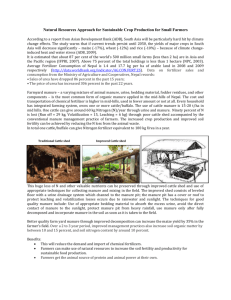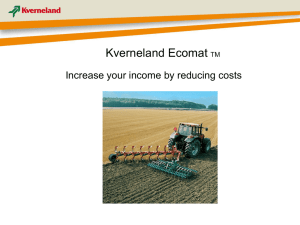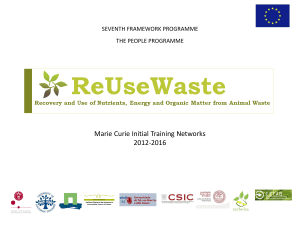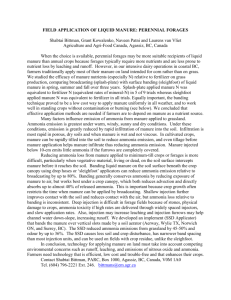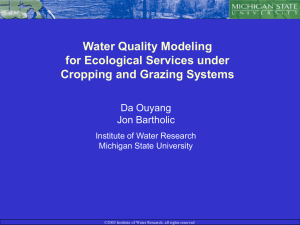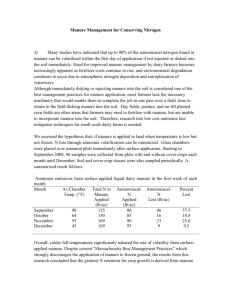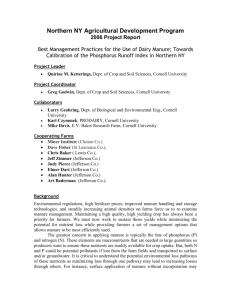Effect of long-term cattle manure application on soil test phosphorus
advertisement
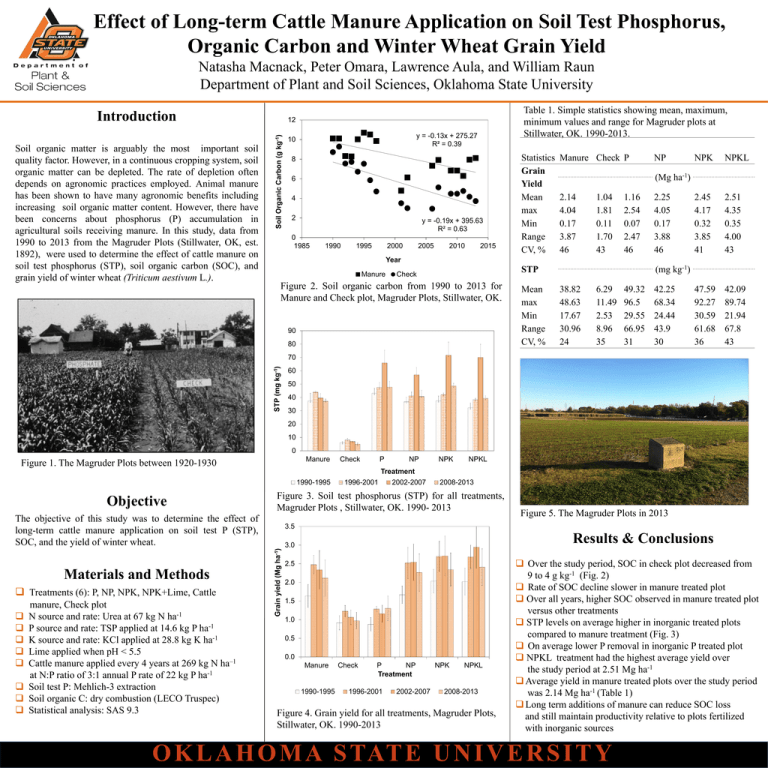
Effect of Long-term Cattle Manure Application on Soil Test Phosphorus, Organic Carbon and Winter Wheat Grain Yield Natasha Macnack, Peter Omara, Lawrence Aula, and William Raun Department of Plant and Soil Sciences, Oklahoma State University Introduction 12 Soil Organic Carbon (g kg-1) Soil organic matter is arguably the most important soil quality factor. However, in a continuous cropping system, soil organic matter can be depleted. The rate of depletion often depends on agronomic practices employed. Animal manure has been shown to have many agronomic benefits including increasing soil organic matter content. However, there have been concerns about phosphorus (P) accumulation in agricultural soils receiving manure. In this study, data from 1990 to 2013 from the Magruder Plots (Stillwater, OK, est. 1892), were used to determine the effect of cattle manure on soil test phosphorus (STP), soil organic carbon (SOC), and grain yield of winter wheat (Triticum aestivum L.). Table 1. Simple statistics showing mean, maximum, minimum values and range for Magruder plots at Stillwater, OK. 1990-2013. y = -0.13x + 275.27 R² = 0.39 10 8 6 4 2 y = -0.19x + 395.63 R² = 0.63 0 1985 1990 1995 2000 2005 2010 2015 Statistics Grain Yield Mean max Min Range CV, % Manure Check P NP NPK NPKL 2.45 4.17 0.32 3.85 41 2.51 4.35 0.35 4.00 43 47.59 92.27 30.59 61.68 36 42.09 89.74 21.94 67.8 43 (Mg ha-1) 2.14 4.04 0.17 3.87 46 1.04 1.81 0.11 1.70 43 1.16 2.54 0.07 2.47 46 2.25 4.05 0.17 3.88 46 Year Manure (mg kg-1) STP Check Figure 2. Soil organic carbon from 1990 to 2013 for Manure and Check plot, Magruder Plots, Stillwater, OK. 90 80 Mean max Min Range CV, % 38.82 48.63 17.67 30.96 24 6.29 11.49 2.53 8.96 35 49.32 96.5 29.55 66.95 31 42.25 68.34 24.44 43.9 30 STP (mg kg-1) 70 60 50 40 30 20 10 0 Manure Figure 1. The Magruder Plots between 1920-1930 Check P NP NPK NPKL Treatment 1990-1995 Objective Grain yield (Mg manure, Check plot -1 N source and rate: Urea at 67 kg N ha -1 P source and rate: TSP applied at 14.6 kg P ha K source and rate: KCl applied at 28.8 kg K ha-1 Lime applied when pH < 5.5 Cattle manure applied every 4 years at 269 kg N ha–1 -1 at N:P ratio of 3:1 annual P rate of 22 kg P ha Soil test P: Mehlich-3 extraction Soil organic C: dry combustion (LECO Truspec) Statistical analysis: SAS 9.3 2008-2013 Figure 5. The Magruder Plots in 2013 3.5 ha-1) Treatments (6): P, NP, NPK, NPK+Lime, Cattle 2002-2007 Figure 3. Soil test phosphorus (STP) for all treatments, Magruder Plots , Stillwater, OK. 1990- 2013 The objective of this study was to determine the effect of long-term cattle manure application on soil test P (STP), SOC, and the yield of winter wheat. Materials and Methods 1996-2001 Results & Conclusions 3.0 2.5 2.0 1.5 1.0 0.5 0.0 Manure 1990-1995 Check P NP Treatment 1996-2001 2002-2007 NPK NPKL 2008-2013 Figure 4. Grain yield for all treatments, Magruder Plots, Stillwater, OK. 1990-2013 Over the study period, SOC in check plot decreased from 9 to 4 g kg-1 (Fig. 2) Rate of SOC decline slower in manure treated plot Over all years, higher SOC observed in manure treated plot versus other treatments STP levels on average higher in inorganic treated plots compared to manure treatment (Fig. 3) On average lower P removal in inorganic P treated plot NPKL treatment had the highest average yield over the study period at 2.51 Mg ha-1 Average yield in manure treated plots over the study period -1 was 2.14 Mg ha (Table 1) Long term additions of manure can reduce SOC loss and still maintain productivity relative to plots fertilized with inorganic sources O K L A H O M A S TAT E U N I V E R S I T Y


